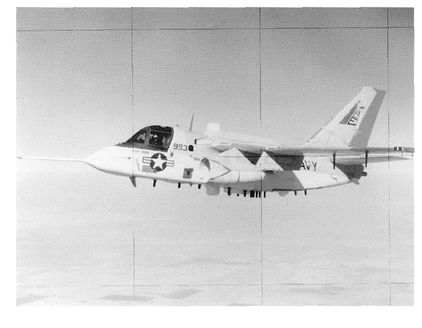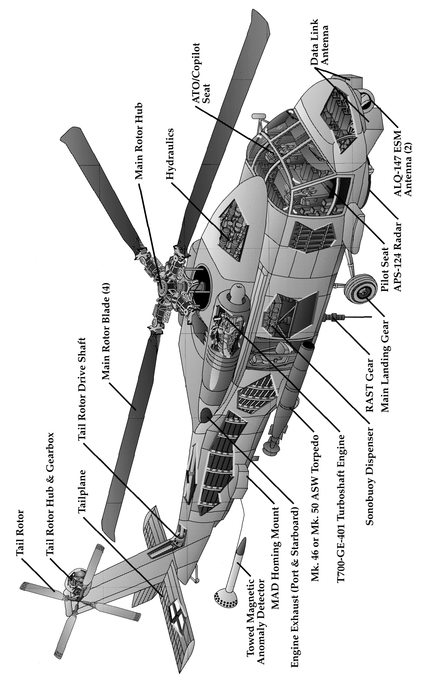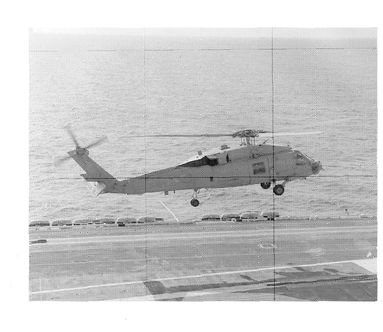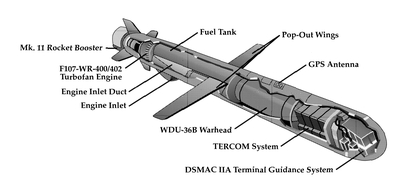Carrier (1999) (38 page)
Authors: Tom - Nf Clancy


The prototype ES-3A Shadow on a test flight. The sixteen Shadows provided the fleet with electronic reconnaissance and surveillance services until recently.
JOHN D. GRESHAM
One of the original hopes for the S-3 was to provide a basic airframe for a number of other aircraft types. Unfortunately, the small production run of the Viking has limited its opportunities for other roles. A small number of early S-3As were modified by removing all the ASW equipment and fittings for armament, allowing them to carry urgent cargo and mail and providing seats for a crew of three and up to six passengers (with minimal comfort). Designated US-3A and possessing a much longer range than the normal C-2A Greyhound COD aircraft, a total of five served in the Pacific fleet until they were recently retired. A dedicated tanker version, the KS-3A, was tested in 1980, but never went into production.
The single most important variant was the ES-3A “Shadow,” an electronic surveillance (ESM) and signals intelligence (SIGINT) platform, which replaced the venerable EKA-3B “Electric Whale.” Externally, the Shadow is quite distinctive, with a prominent dorsal hump and a retractable radome. About 3,000 lb/1,360 kg of ASW gear was removed and 6,000 lb/2,721 kg of electronics were packed into the weapons bay. While the Shadow is unarmed, it can also carry external fuel tanks and “buddy” refueling stores. Sixteen of these aircraft are split between two squadrons: VQ-5 (the “Sea Shadows”) in the Pacific Fleet and VQ-6 (the “Ravens”) in the Atlantic. Detachments of two or three aircraft normally deploy with every carrier air group, providing ESM, SIGINT, and OTH support for the CVBG. Unfortunately, recent budget cuts have targeted the shadow community which appears to be headed for disestablishment. Plan on seeing the ES-3 head for the boneyard in 1999.
The S-3 community has changed a great deal since the end of the Cold War. As long as the Soviet Union maintained the world’s largest submarine fleet, the ASW squadron was an integral part of the carrier air group. But today, that “blue-water” submarine threat has receded. This hardly means that the S-3’s can be retired and their crews given pink slips. On the contrary, the VS squadrons have taken on a whole new set of roles and missions, making them more valuable than ever. After the premature retirement of the KA-6D fleet in 1993, they took on still another role, becoming the primary aerial refueling tanker for the CVW. This has not proved to be the best solution to the aerial refueling problem, since an S-3B can only off-load about 8,000 lb/3,628 kg of fuel, as compared to over 24,000 lb/10,886 kg for the KA-6D. With the thirsty F/A-18’s needing at least 4,000 lb/1,814 kg every time they go on a long CAP or strike mission, even the ES-3 Shadows are being used as tankers! To reflect all this, the previous ASW designation of their squadrons has been changed to “Sea Control,” which uses the “VS” nomenclature.
The S-3B community currently includes ten operational squadrons, administratively divided between two Sea Control Wings: one for the Atlantic Fleet and one for the Pacific. A single Fleet Replacement Squadron, VS-41, based at North Island NAS, California, serves as the advanced training unit. During Operation Desert Shield and Desert Storm, S-3 squadrons flew maritime patrols to help enforce sanctions against Iraq. In fact, the only complaint I’ve ever heard about this wonderful aircraft is that the Navy bought too few of them. Another two hundred would have been invaluable today, but the poor choices on the part of naval aviation leaders scuttled that idea. At the end of 1997, about 120 S-3’s remained in service. Eventually, all of their tasks will be taken over by the future Common Support Aircraft that is scheduled to enter service around 2015.
Sikorsky H-60 Seahawk: A Family of WinnersFixed-wing aircraft that hunt submarines on the prowl have one major vice: They move too fast. One solution is to use an aircraft that can stand still, dip a sonar into the water, and just listen for a while, the way a surface ship or submarine can. Then, if needed, it can rapidly dash to another spot, and do it all again. In other words, you need ASW helicopters. The Germans were the first to use helicopters for this purpose. During World War II they used them to hunt Russian submarines in the Baltic Sea. Following the war, it was only a matter of time and technological development until a true ASW helicopter was developed. After several false starts in the 1950’s, Sikorsky developed the SH-3 Sea King. One of the finest helicopters ever built, it was equipped with a dipping sonar and homing torpedoes, and had plenty of range and power. However, by the mid-1970’s it was clear that the old SH-3 was heading into its last legs as the USN’s premier sub-hunting helicopter.
Meanwhile, the USN had operated another fleet of ASW choppers, so-called “light” helicopters, which can operate off small platforms on escort ships. Starting in the late-1960’s, this mission was filled by the Kaman SH-2 Seasprite LAMPS I (Light Airborne Multi-Purpose System). For three decades ,SH-2’s have operated off the Navy’s smallest ships (such as the now-retired
Knox-class
(FF-1052) frigates), and are still being produced for foreign navies. While the SH-2 was a good start, it lacked the range and payload to hunt front-line Soviet submarines. The Navy wanted a LAMPS helicopter that could hunt the new generation of Soviet submarines coming into service, and began development in the early 1970s.
Knox-class
(FF-1052) frigates), and are still being produced for foreign navies. While the SH-2 was a good start, it lacked the range and payload to hunt front-line Soviet submarines. The Navy wanted a LAMPS helicopter that could hunt the new generation of Soviet submarines coming into service, and began development in the early 1970s.

In 1977, the Navy awarded a contract to IBM Federal Systems and Sikorsky to build a new light ASW helicopter system called Light Airborne Multi-Purpose System—Mark III (LAMPS III).
57
The helicopter itself was called the SH-60B Seahawk. The SH-60B was developed from Sikorsky’s UH-60 Blackhawk transport helicopter, which had recently won the Army’s competition to replace the venerable UH-1 “Huey.”
58
This saved a lot of development money for the Navy and gave them an airframe with excellent growth potential.
57
The helicopter itself was called the SH-60B Seahawk. The SH-60B was developed from Sikorsky’s UH-60 Blackhawk transport helicopter, which had recently won the Army’s competition to replace the venerable UH-1 “Huey.”
58
This saved a lot of development money for the Navy and gave them an airframe with excellent growth potential.
Equipped with sonobuoys, MAD, radar, and other detection gear, the SH-60B would be the helicopter equivalent of the S-3B for escort ships. The LAMPS III birds would be based aboard the new generation of
Ticonderoga-
class (CG-47) Aegis cruisers,
Spruance
(DD-963) and
Kidd-class
(DDG-993) destroyers, and
Oliver Hazard
Perry-class (FFG-7) frigates. These ships were being designed with enlarged helicopter hangars and landing platforms, and a combat center with two-way data links to process information from the SH- 60’s onboard sensors. When they first deployed in 1984, the LAMPS III-CAPABLE ships were the most powerful ASW escorts in the world. In a task force or convoy, they would form an “outer zone” barrier against any submarines trying to attack.
Ticonderoga-
class (CG-47) Aegis cruisers,
Spruance
(DD-963) and
Kidd-class
(DDG-993) destroyers, and
Oliver Hazard
Perry-class (FFG-7) frigates. These ships were being designed with enlarged helicopter hangars and landing platforms, and a combat center with two-way data links to process information from the SH- 60’s onboard sensors. When they first deployed in 1984, the LAMPS III-CAPABLE ships were the most powerful ASW escorts in the world. In a task force or convoy, they would form an “outer zone” barrier against any submarines trying to attack.
Meanwhile, it was time to replace the SH-3, the protectors of the “inner zone” of ASW defenses for the CVBG. Once the SH-60Bs had been well launched, it was a logical jump to build a Sea King replacement from the existing Seahawk airframe. In 1985 the USN contracted with Sikorsky for development and production of seventy-four “CV-Helo” versions of the H-60. They would be equipped with a new lightweight dipping sonar and some avionics improvements over the earlier-B-model Seahawks. These improvements came at a price, however: the loss of most of the LAMPS equipment, including the sonobuoy launchers and data links. The new SH-60F came into service in 1989, and began to replace the elderly SH-3’s aboard the carriers. At this same time, in response to- an ongoing initiative to expand the special warfare capabilities of the USN, another H-60 variant went into development. The HH-60H version of the Seahawk provided a whole new range of capabilities for battle groups commanders, including Combat Search and Rescue (CSAR) and the covert insertion and retrieval of Special Forces like the famous Sea-Air-Land (SEAL) teams.

An HH-60G special operations/SAR helicopter landing on the deck of the USS
George Washington
(CVN-73).
George Washington
(CVN-73).
JOHN D. GRESHAM
Having three aircraft all based upon the same H-60 airframe has saved lots of scarce naval aviation dollars. All share the same 1,690-horsepower General Electric T700 turboshaft engines, as well as a common rotor system (with a diameter of 53 feet, 8 inches/16.4 meters) and transmission. In fact, the primary differences between the -B, -F, and -H versions are in the various mission-equipment packages. With an overall length of 64 feet, 10 inches/ 19.75 meters, height of 17 feet/5.2 meters, and maximum gross weight of 21, 884 lb/9,908 kg, the Seahawk is a compact and nimble aircraft. It handles well on wet, rolling decks, even those of small escort ships. To assist ships’ crews in handling, Seahawks have a cable system called RAST (Recovery, Assist, Secure, and Traversing), allowing ships’ crews to haul it down safely in heavy seas. Developed from the Canadian “Beartrap” system, RAST has a tracked receiver on the helicopter platform, which “captures” a small cable hanging from the bottom of the helicopter. Once the receiver has snagged the cable, the helicopter is hauled down, and then towed into the ship’s hangar.
The armament of the Seahawks, while limited, is well tailored for their assigned missions. The normal weapons load for the ASW versions is a pair of Mk. 46 or Mk. 50 lightweight torpedoes. Extra fuel tanks can also be carried to extend the Seahawk’s range. The -B model is also equipped to fire the Norwegian-built AGM-119 Penguin Mk. 2 Mod. 7 ASM. With a range of up to 18 nm/33 km and a passive infrared seeker, it can take out a patrol boat or small escort ship, even in close proximity to a shoreline or neutral shipping traffic. All the variants of the Seahawk can be fitted with light machine guns, and have rescue hoists for hauling in downed air crews or other personnel.
The various models of Seahawk have helped maintain the sometimes-dicey peace in the post-Cold War world. In the Persian Gulf, for instance, LAMPS III birds have been monitoring maritime traffic and the maritime embargo of military materials into Iraq. At the same time, the -F models have kept a wary eye on the three Project 877/Kilo-class diesel boats of the Iranian Navy, and -H model Seahawks have been transporting inspection teams to ships and conducting CSAR missions. Seahawks have been active in supporting our operations in Bosnia as well. In fact, you probably could not even operate a modern USN task force without Seahawks. This is emphasized by the continuing popularity of the H-60 to export customers around the world. So far, Spain, Japan, Australia, and Taiwan have all bought their own versions of the Seahawk to operate off various classes of escort.

Other books
Lending Light (Gives Light Series Book 5) by Rose Christo
Isle of Wysteria: The Reluctant Queen by Aaron Lee Yeager
Stepbrother: Impossible Love by Victoria Villeneuve
Stranded by Alex Kava
Darcy's Journey by M. A. Sandiford
The story of Lady Hamilton by Meynell, Esther
The Mammoth Book of New Jules Verne Adventures by Mike Ashley, Eric Brown (ed)
First We Take Manhattan by Mina MacLeod
Suspicion by Alexandra Moni
No Place Like Home by Leigh Michaels
